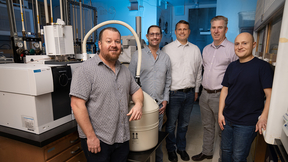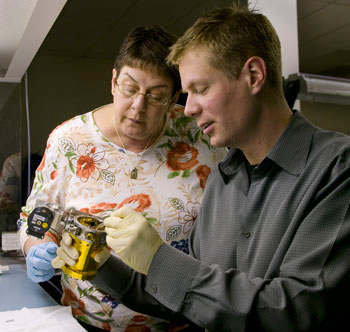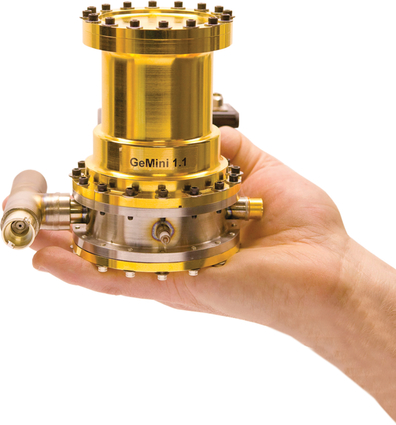Lab detects need for new radiation technologies
September 11, 2001 served as a turning point for the United States. The first major attack on U.S. soil in nearly 60 years and the largest loss of life due to terrorism ever experienced on these shores created a sense of overarching vulnerability, and exposed concerns that once seemed far-fetched to be more real than once imagined.
"I think there was a realization that it could have been much worse. If the adversary had nuclear capability, they would have used it, and we would have been looking at hundreds of thousands of deaths," LLNL scientist Mike Carter said. "We realized that our pre-9/11 strategy would have failed had they had that capability, and we felt a sense of urgency to change that. There were the building blocks for radiation detection technology out there already, but it wasn't ready for massive-scale, prime-time deployment."
The landscape changes
Carter, who has worked in the Lab's nonproliferation and counterterrorism programs, was recruited to Washington shortly after 9/11 to take part in the White House team that helped stand up the Department of Homeland Security, where he led the radiation detection portfolio and directed the development of the national R&D strategy for improving radiation detection technology. The portfolio began investing in institutions across the country, including the Laboratory, to grow a workforce that knew they had stable R&D dollars focused on problems that were important to the long-term security of the country. In a few short years, the portfolio grew from $35 million to more than $350 million, spurring a flood of new projects focused on improving detection technologies.
According to Steve Kreek, leader of LLNL's Nuclear Detection and Countermeasures Research Program, much of the radiation detection technology research prior to 9/11 was focused on other applications, such as safeguards, treaty enforcement and nuclear materials protection. After the attacks, that focus didn't go away, but there was a new component that took precedence: counterterrorism.
"Where we weren't necessarily worried about an attack prior to 9/11, we were worried about an attack after 9/11. We were concerned about countries getting materials they shouldn't have prior to the attacks, and after we were concerned about terrorist organizations obtaining and actually using them," Kreek said. "But while the concerns were very different in focus, the detection technologies themselves actually didn't change much -- the application changed."
Like Carter, Kreek also brought his expertise to Washington, D.C., where they worked together on the initial groundwork for the development of a national detection and deterrence system. Many of the same problems with detection technologies that held true for pre-9/11 applications were still in play after 9/11. The problems became more complicated, he said, because post-9/11, the devices employing those technologies had to work within normal commerce environments, where they would be used much more frequently and be much more broadly distributed.
Lab rises to meet the challenge
When the 9/11 attack happened, efforts to solve the known shortcomings of radiation detection technologies were already well under way at LLNL, with a number of projects working to improve the ability to find and identify potential nuclear or radioactive threats. Radiation detection research has a long history at LLNL, with success stemming from the combination of different expertise found throughout the Lab, ranging from physics to materials science to algorithms development to engineering and computations.
One of those successes resulted in the development of the Detective, a hand-held gamma-ray detector used to identify materials with radioactive signatures. Commercialized in 2003, the device serves as the first portable, mechanically cooled, high-purity germanium-based detector of its kind and has been deployed all over the world. Used in shipping ports or border crossings or by emergency-response personnel, the Detective can quickly and accurately discriminate between harmless sources of radiation from those of concern.
LLNL has taken the technology one step further with the development of the GeMini, the next generation of gamma-ray spectroscopy. Also incorporating germanium, the GeMini brings high-resolution technology to the field with an ultra-miniature cooling system that makes it smaller, more cost-effective and better able to withstand the rigors of field deployment. According to Morgan Burks, leader of the GeMini development team, a high-resolution gamma-ray spectrometer is important in making positive identifications of radioactive sources and providing critical information needed for response decisions.
"Radiation detection had always been of interest to science. But 9/11 really changed things, and suddenly it became critically important for national security," he said. "There was a much bigger need to have high-resolution radiation detection widely deployed. You had two choices in the past: you could have a highly transportable, but poor-resolution radiation detector, or you could have high resolution, but only in the lab. The devices that we've developed bring those capabilities together."
The GeMini development team is planning for commercialization in the next year and expects to see the device follow in the Detective's steps, with deployment around the world. In the meantime, a gamma-ray spectrometer -- which served as the predecessor of the GeMini -- is collecting data from Mercury on NASA's Messenger spacecraft, advancing the pure science behind the continued development of these detectors.
"There's a lot of technology that we've developed for that space mission that has helped us to make a better generation of handheld detection systems," Burks said. "We've incorporated that technology back into the new generation."
Another LLNL-based technology is the Fission Meter, which employs a neutron detector and highly specialized analysis to detect and identify special nuclear materials, even when the neutron signal strength is at background levels. This device is highly capable of making the differentiation between dangerous fissile material and innocuous sources with high neutron counts.
According to Simon Labov, associate program leader for Radiation Detection Systems at LLNL, these technologies serve as good examples of something the Lab does very well -- leveraging its legacy of capabilities and expertise to develop advanced technologies with a strong science foundation. "We have a great ability to build and test things here. It's difficult to develop new technology that works in the laboratory, but even more difficult to take that technology and get it into a form where it can be put in the hands of people who need it," he said "The focus after 9/11 gave us the opportunity to expand what we were already working on and to come up with new technology. It's been tremendously successful, and its very exciting to see these technologies all go forward."
Contact
Breanna Bishop[email protected]
925-423-9802
Tags
Global SecurityStrategic Deterrence
Featured Articles









